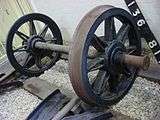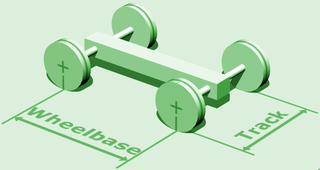Wheelset (rail transport)
A wheelset is the wheel - axle assembly of a railroad car. The frame assembly beneath each end of a car, railcar or locomotive that holds the wheelsets is called the bogie (or truck in North America). Most North American freight cars have two bogies with two or three wheelsets, depending on the type of car; short freight cars generally have no bogies but instead have two wheelsets.
Grovers bogie
Two-axle cars operating on lines with sharp curves, such as Queensland Railways, used Grovers bogies.[1][2][3]
Special wheelsets

Rubber-tyred metros feature special wheelsets with rubber tyres outside of the special flanged steel wheels. The unusually large flanges on the steel wheels guide the bogie through standard railroad switches and in addition keep the train from derailing in case the tires deflate.
Semi-conical shape
Most train wheels have a semi-conical taper of about 1 in 20. The semi-conical shape helps steer the wheel set around curves, so that the wheel flanges do not come in contact with the rail sides. The rails generally slant inwards at the same rate as the wheel conicity. As the wheels approach a curve, they tend to continue in a straight path due to the inertia of the rail car. This inertia makes the wheel set to shift sideways as the track curves under it. Due to this fact, the effective diameter of the outer wheels needs to be greater than that of the inner ones. Since the wheels are joined rigidly by the axle, the outer wheels travel farther, then causing the train to naturally follow the curve. For more information on this process, see Hunting oscillation.
Queensland Railways, for its first hundred years, used cylindrical wheels and vertical rails.[4][5][6] With non-inclined rails and cylindrical wheels, the wheel squeal from trains taking curves on that railway was slight. After adopting coned wheels and inclined rails from the mid 1980s, the wheel squeal from trains curving at the same location and at the same speed increased immensely. Some modern systems, such as Bay Area Rapid Transit (BART) in San Francisco, use cylindrical wheels and flat-topped rails; BART is now switching to conical tread to reduce the noise caused by flange/rail contact and loss of adhesion of one of the wheels on curves.[7]
Gallery
-

A wheelset from a GWR wagon, showing a plain bearing end
-
Two wheelsets with journal boxes in a North American (Bettendorf-style) freight bogie displayed at the Illinois Railway Museum.
-
Wheelset Monument in Kharkov
-
Rail axle at the Texas Transportation Museum
-

Railway wheel flange, left, and tram wheel flange, right
-

Railroad car wheels are affixed to a straight axle, such that both wheels rotate in unison. This is called a wheelset.
-

Track = wheel gauge (measured between the gauge or flange reference lines of the flanges of railroad wheels)
See also
References
- ↑ Grovers bogie
- ↑ Grovers Bogie under 4 wheel wagon
- ↑ Drawing of Govers Bogie wagon
- ↑ J W Knowles, Radial Wheeled Rolling Stock on the Queensland Railways, Australian Railway Historical Society Bulletin, Vol XXV, No 438, April 1974, pp 75 – 92;
- ↑ John Knowles, The Queensland Railways and its Cylindrical Wheels,Sunshine Express, Vol 17, No. 189., December 1981, p 241.
- ↑ John Knowles, More on the Queensland Railways and its Cylindrical Wheels,Sunshine Express, Vol 19, No. 210, September 1983, p 210.>
- ↑ "The Four-Year Fight to Make San Francisco's Subway Stop Screaming". Wired. 2016-09-02.
Sources
- Matthias N. Forney (1974) [1879]. The Railroad Car Builder's Dictionary. Dover Publications, Inc.
- White, John H. (1978). The American Railroad Passenger Car. Baltimore, MD: Johns Hopkins University Press. ISBN 0801819652. OCLC 2798188.
- White, John H. Jr. (1993). The American Railroad Freight Car: From the Wood-Car Era to the Coming of Steel. Baltimore: Johns Hopkins University Press. ISBN 0-8018-4404-5. OCLC 26130632.
External links
- "APTA PR-CS-RP-003-98 Recommended Practice for Developing a Clearance Diagram for Passenger Equipment 5.3.2.1 Design tolerances" (PDF). APTA.com. American Public Transportation Association. 1998-03-26. Retrieved 2015-01-17.
- Train wheels
